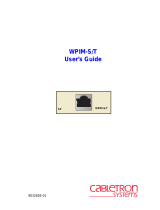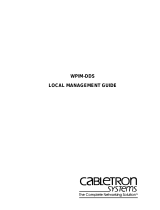
1166-024-850 Rev. A
Ordering Primary Rate ISDN for the
Remote Annex 6300
This guide tells you how to order Primary Rate ISDN (PRI) lines for
use with the Remote Annex 6300 PRI module in the USA and Canada
only. For the most up-to-date version of this document, please see the
Bay Networks World Wide Web site at
http://www.baynetworks.com.
Primary Rate ISDN
In North America, Primary Rate ISDN is provided over the same physical
circuit as a T1 leased line, from what is known as the ‘trunk side’ of your
telephone company’s central office switch. The main difference between
a T1 and a PRI line lies in how a PRI line is split up into 23 B (or ‘bearer’)
channels plus one D (‘delta’ or signaling) channel, and in how calls are
set up and controlled. As with Basic Rate ISDN, the B channels each have
a 64 kpbs capacity. Unlike Basic Rate ISDN, however, the D channel also
has a 64 kbps capacity, rather than 16 kpbs.
This edition of the guide covers product versions which require an
external Channel Service Unit (CSU). A CSU is a device that provides
electrical isolation between the telephone company’s line and your
equipment, along with remote diagnostic capabilities so that the phone
company can test the line. An External CSU is bundled with Remote
Annex shipments for the U.S. and Canada. Follow the installation
instruction included with the CSU.
Service Options
You should be aware that both local and long distance phone companies
can provide PRI services, but that exact service options may differ
between them. Contact your carriers for more details. For North America,
the Remote Annex 6300 supports 5ESS, DMS100 and NI-2 switches.

166-024-850 Rev. A
Ordering Primary Rate ISDN for the Remote Annex 6300
2
You should select the following options (where available) when ordering
your PRI line:
• Framing and line encoding: ask for Extended Superframe
Format (ESF) with B8ZS line encoding. These options are
necessary to ensure 64 kbps clear channels are available. The
Remote Annex 6300 supports both Circuit Switched Data (56/
64 KB) and Circuit Switched Voice.
• Bearer capabilities: ask that the PRI line is provided as
circuit-switched data only or that the bearer capability is
selected on a call-by-call basis. For maximum flexibility, we
recommend that you ask for call-by-call service selection.
• Incoming calling line identification: we recommend enabling
this option, if available, as it can provide a strong level of
access security.
• Clock source: set your CSU to receive clock signals from your
telephone company’s switch, i.e. to be a slave rather than a
master.
• Called party number: request delivery of this option;
typically, the Remote Annex 6300 is configured with this
option to decide how to handle specific incoming call (the user
will configure the 6300 to handle called number xxxx voice
calls, called number yyyy as V.120 calls and called number
zzzz as synchronous PPP calls). Order at least three distinct
phone numbers associated with the PRI line. They should each
be setup as a hunt group spanning all the B channels. DID
service or MSN service will satisfy this requirement. Three
phone numbers is the fastest way to insure calling type.
The Remote Annex 6300 can detect the difference between digital and
analog calls. You can use a single phone number for a combination of
analog and V.120 calls or analog and synchronous PPP calls. Separate
phone numbers are required for a mixture of V.120 and synchronous PPP
calls.
/




